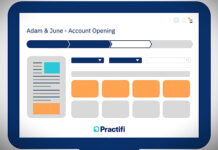BY ADRIAN JOHNSTONE
CCO, PRACTIFI
It’s easy to get starry-eyed with any new technology purchase. Platforms aimed at advisory firms typically promise the world, raising your expectations — sometimes to unrealistic levels. When those solutions fail to deliver enormous results, you might think the technology’s inherently flawed or ineffective. It didn’t live up to that promise, so clearly something must be wrong with the platform, right?
The truth is even the best piece of technology can’t overcome bad data (or bad processes, for that matter, but that’s a discussion for another time). Data cleanliness is an essential part of managing an effective tech stack, keeping systems up to date with accurate information relating to clients, financial planning strategies, regulatory obligations and the firm itself. To help you get started, we’ll cover the meaning of clean data and share some best practices in data maintenance.
What does data cleanliness entail?
Data cleanliness is, admittedly, a fairly generic term, and it can mean a lot of things to different people. For example, you might equate data cleanliness with data quality, and you wouldn’t necessarily be wrong.
So, what do we mean when we talk about data cleanliness? Clean data can cover any or all of these characteristics:
- Accurate: Your databases, systems and platforms are up to date with all the latest information. Data also needs to be 100% correct, whether it’s client contact information or long-term financial goals.
- Complete: You’re not missing any important information, especially details that impact the client’s financial strategy. If a client has a kid who is going to be attending college in a couple of years, for instance, then their financial planner would need to know that to give good advice.
- Organized: Everything is placed in the right location — so client data is stored in your customer relationship management (CRM) system, for instance. Also, you’ve weeded out any duplicate copies of files or records to avoid confusion.
- Essential: Your platform dashboards contain only information that’s useful to advisors as they focus on providing the best services to your clients.
Only use the data you need
Even platforms that are designed specifically for wealth management and advisory firms target a pretty broad audience. Not every feature will be applicable to each user. That’s certainly true with business process management or CRM solutions. Firms will find different capabilities and tools more relevant to their needs than others.
With that in mind, you shouldn’t feel like you need to fill out every field and form you come across if they won’t have a measurable impact on your client relationships. As a result, you’ll likely see a lot of blank fields in your CRM platform.
While you don’t want to leave half of your CRM fields completely empty, don’t waste time filling in information that isn’t important to your firm. If you know your advisors will never need to use certain data, just don’t bother with it.
Today’s business management platforms make it pretty easy to hide fields that aren’t useful or relevant to your firm. Conduct an audit of your CRM to see what information you really need and routinely use, remove the rest from your interface so it doesn’t distract users. Out of sight, out of mind.
Create standard data management policies
A lot of firms have made the mistake of giving their advisors too much leeway in the way they manage data. If you don’t have standard policies and practices in place to guide your staff, you’re going to find that the quality and completeness of your data will vary pretty significantly.
Consider how your firm documents client phone calls, for instance. There’s a good chance each of your advisors handles things differently. Some jot down just a few bullet points while others type out entire paragraphs. Without any consistency in that process, you’ll never know what information — or how much of it — is going to be available.
In a similar vein, you need to be sure that advisors are documenting client relationships using the same fields and uploading the same type of data into your CRM platform. A good way to get everyone on the same page is to create note templates so advisors have a standard list of fields to fill in according to different scenarios. If, for instance, a client calls the office, your team will have a clear process to go through to ensure that interaction — and all the information discussed — is consistently documented.
Build stronger client relationships
Financial advisors should tailor their services and support to each client and give them exactly what they want — and that requires clean data. It’s even more important to have accurate, up-to-date data points right now when advisors are not able to meet clients in person. Having information regarding clients’ family members, financial strategy and personal details all at your advisors’ fingertips helps create a stronger rapport.
Advisors need to meticulously document every conversation and take all the client information swimming around in their heads and upload it to business management platforms so it’s readily available. If a client wants to follow up on a retirement plan that was discussed in their last call, for instance, the advisor can easily pull up that info and give an update.
Client segmentation is important as well — which, again, requires clean data. Although a lot of firms segment clients based on their assets under management, that’s not always the most insightful way to group them. Context matters — a lot. Even something as seemingly straightforward as contact frequency should be approached from different angles depending on the client. A single parent with teenage children is probably too busy to have frequent conversations about their financial plans. Meanwhile, a retired grandparent who has lots of free time might jump at every opportunity to hop on a call with a financial advisor.
It’s important to remember that data cleanliness is an ongoing job. You need to routinely audit your tech stack to check that your data is up to date, accurate and useful. What you consider important data could change from quarter to quarter or even month to month. So, be diligent and take the time to ensure your entire firm follows data cleanliness best practices.







